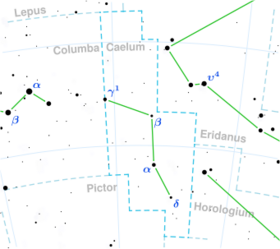Astronomy:Nu Caeli
| Observation data Equinox J2000.0]] (ICRS) | |
|---|---|
| Constellation | Caelum |
| Right ascension | 04h 50m 16.18032s[1] |
| Declination | −41° 19′ 15.0557″[1] |
| Apparent magnitude (V) | 6.07[2] |
| Characteristics | |
| Spectral type | F2/3 V[3] or F1 III-IV[4] |
| B−V color index | +0.37[2] |
| Astrometry | |
| Radial velocity (Rv) | +23.8±0.8[5] km/s |
| Proper motion (μ) | RA: −3.846[1] mas/yr Dec.: +66.201[1] mas/yr |
| Parallax (π) | 20.2691 ± 0.0215[1] mas |
| Distance | 160.9 ± 0.2 ly (49.34 ± 0.05 pc) |
| Absolute magnitude (MV) | +2.46[6] |
| Details | |
| Mass | 1.34[7] M☉ |
| Radius | 2.107[8] R☉ |
| Luminosity | 8.011[8] L☉ |
| Surface gravity (log g) | 4.20±0.14[7] cgs |
| Temperature | 6,696[8] K |
| Metallicity [Fe/H] | −0.11[9] dex |
| Rotational velocity (v sin i) | 44.9[10] km/s |
| Age | 880[7] Myr |
| Other designations | |
| Database references | |
| SIMBAD | data |
Nu Caeli (ν Caeli) is a yellow-white hued star in the constellation Caelum. It has an apparent visual magnitude of 6.07, which indicates it is near the lower limit on brightness that is visible to the naked eye. According to the Bortle scale, the star can be viewed from dark suburban skies. Based upon an annual parallax shift of 20.3 mas as seen from Earth, this star is located 161 light years from the Sun.
Houk (1978) listed a stellar classification of F2/3 V for Nu Caeli,[3] which would indicate this is an F-type main-sequence star.[3] In contrast, Malaroda (1975) assigned it to class F1 III-IV,[4] which would suggest it is a more evolved F-type subgiant/giant transitional object. It is an estimated 880 million years old with 1.34 times the mass of the Sun.[7] The star is radiating eight times the Sun's luminosity from its photosphere at an effective temperature of 6,596 K.[8]
A companion is listed in multiple star catalogues. It is a 10th-magnitude star about 13″ away,[12][13] much further away than ν Caeli and unrelated.[14]
References
- ↑ 1.0 1.1 1.2 1.3 1.4 Brown, A. G. A. (2021). "Gaia Early Data Release 3: Summary of the contents and survey properties". Astronomy & Astrophysics 649: A1. doi:10.1051/0004-6361/202039657. Bibcode: 2021A&A...649A...1G. Gaia EDR3 record for this source at VizieR.
- ↑ 2.0 2.1 Johnson, H. L. et al. (1966), "UBVRIJKL photometry of the bright stars", Communications of the Lunar and Planetary Laboratory 4 (99): 99, Bibcode: 1966CoLPL...4...99J.
- ↑ 3.0 3.1 3.2 Houk, N. (1978), Michigan catalogue of two-dimensional spectral types for the HD stars, 2, Dept. of Astronomy, University of Michigan, Bibcode: 1978mcts.book.....H.
- ↑ 4.0 4.1 Malaroda, S. (August 1975), "Study of the F-type stars. I. MK spectral types", Astronomical Journal 80: 637–641, doi:10.1086/111786, Bibcode: 1975AJ.....80..637M.
- ↑ de Bruijne, J. H. J.; Eilers, A.-C. (October 2012), "Radial velocities for the HIPPARCOS-Gaia Hundred-Thousand-Proper-Motion project", Astronomy & Astrophysics 546: 14, doi:10.1051/0004-6361/201219219, A61, Bibcode: 2012A&A...546A..61D.
- ↑ Holmberg, J. et al. (July 2009), "The Geneva-Copenhagen survey of the solar neighbourhood. III. Improved distances, ages, and kinematics", Astronomy and Astrophysics 501 (3): 941–947, doi:10.1051/0004-6361/200811191, Bibcode: 2009A&A...501..941H.
- ↑ 7.0 7.1 7.2 7.3 David, Trevor J.; Hillenbrand, Lynne A. (2015), "The Ages of Early-Type Stars: Strömgren Photometric Methods Calibrated, Validated, Tested, and Applied to Hosts and Prospective Hosts of Directly Imaged Exoplanets", The Astrophysical Journal 804 (2): 146, doi:10.1088/0004-637X/804/2/146, Bibcode: 2015ApJ...804..146D.
- ↑ 8.0 8.1 8.2 8.3 Schofield, Mathew; Chaplin, William J.; Huber, Daniel; Campante, Tiago L.; Davies, Guy R.; Miglio, Andrea; Ball, Warrick H.; Appourchaux, Thierry et al. (2019), "The Asteroseismic Target List for Solar-like Oscillators Observed in 2 minute Cadence with the Transiting Exoplanet Survey Satellite", The Astrophysical Journal Supplement Series 241 (1): 12, doi:10.3847/1538-4365/ab04f5, Bibcode: 2019ApJS..241...12S.
- ↑ Casagrande, L. et al. (2011), "New constraints on the chemical evolution of the solar neighbourhood and Galactic disc(s). Improved astrophysical parameters for the Geneva-Copenhagen Survey", Astronomy & Astrophysics 530 (A138): 21, doi:10.1051/0004-6361/201016276, Bibcode: 2011A&A...530A.138C.
- ↑ Glebocki, R.; Gnacinski, P. (2005), "VizieR Online Data Catalog: Catalog of Stellar Rotational Velocities (Glebocki+ 2005)", VizieR On-line Data Catalog: III/244. Originally Published in: 2005csss...13..571G; 2005yCat.3244....0G 3244, Bibcode: 2005yCat.3244....0G.
- ↑ "HD 30985". SIMBAD. Centre de données astronomiques de Strasbourg. http://simbad.u-strasbg.fr/simbad/sim-basic?Ident=HD+30985.
- ↑ Mason, B. D. et al. (2014), "The Washington Visual Double Star Catalog", The Astronomical Journal 122 (6): 3466, doi:10.1086/323920, Bibcode: 2001AJ....122.3466M.
- ↑ Dommanget, J. et al. (2002). "Catalog of Components of Double & Multiple stars". Observations et Travaux 54 (5). Bibcode: 2002yCat.1274....0D.
- ↑ Brown, A. G. A. (2021). "Gaia Early Data Release 3: Summary of the contents and survey properties". Astronomy & Astrophysics 649: A1. doi:10.1051/0004-6361/202039657. Bibcode: 2021A&A...649A...1G. Gaia EDR3 record for this source at VizieR.
External links
- HR 1557 VizieR Bright Star Catalogue entry
- CCDM J04503-4119 Vizier Catalog of Components of Double and Multiple stars
- Nu Caeli Aladin Image
- Wikisky
 |


